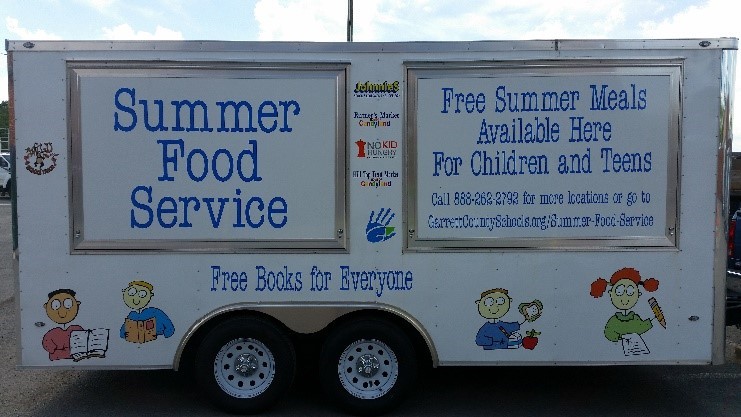 Local Lunch Boosts Summer Flavor
Garrett County Public Schools (GCPS) is a rural community in western Maryland with 3,839 students (47% free and reduced rate). Over several years, the GCPS Food and Nutrition Services Department has enhanced their Summer Food Service Program with the addition of three mobile routes and two school locations. Making Summer mobile has increased programmatic efficiency, as dining trailers can easily pull into a parking area and quickly open for service. The trailers’ concession windows allow for friendly meal service, while the interior benches and tables offer children a safe dining space during inclement weather.
One of the Program’s goals is to serve as many local items as possible. In the past, GCPS has struggled to serve local produce due to a late growing season. Not easily deterred, GCPS explored other local food options, finding great success with meat and cheese items! This summer, the Program is looking to add local pork for pulled pork sandwiches and local buckwheat for their buckwheat brownies. Yummy! Later this season, the Program will serve a summer classic - fresh corn on the cob! GCPS offers at least three different entrée choices every day, many of which are served hot and scratch-made. Some of the items include scratch-made mac-and-cheese, sloppy joes, chicken salad, and chef salads, as well as local Italian sausages.
During 2018, GCPS served 13,469 summer meals. This year, the Program hopes to serve even more locally-sourced, scratch-made meals!

Sponsor an AmeriCorps Team!
Need help growing your Farm to Summer program? Host a team of AmeriCorps volunteers! AmeriCorps National Civilian Community Corps (NCCC) provides team-based, direct service for non-profits, community, faith-based organizations, schools, local municipalities, state and federal entities, and Tribal governments. NCCC members are young adults, 18-24 years old, who participate in a residential 10-month service term, and represent a wide variety of socioeconomic, cultural, geographic, and educational backgrounds. Team sizes vary and can range from 6-12 Corps Members. The NCCC teams help strengthen communities through a wide variety of tasks within six program areas that include examples such as:
-
Healthy Futures: Food security direct service programming, community gardening, summer meals support, nutrition education and wellness activities.
-
Disaster Recovery: Deconstruction and rebuilding of homes, debris removal, or sorting donations after natural or other disasters.
-
Education: Tutoring and mentoring youth during school, after school, or in summer programs.
-
Economic Opportunity: Affordable housing construction, tax preparation, community revitalization.
-
Environment: Habitat restoration, trail building, interpretative programming.
-
Veterans and Military Families: Building facilities or structures to support veteran services and programming.

Save the Date: 10th National Farm to Cafeteria Conference
April 20-24, 2020 // Albuquerque, New Mexico
The 10th National Farm to Cafeteria Conference is coming to Albuquerque, New Mexico, April 20-24, 2020! Hosted by the National Farm to School Network, this biennial event will convene a diverse group of food service professionals, farmers, educators, students, representatives from nonprofits and government agencies, public health professionals and more to learn, network, and strengthen this important movement. Are you passionate about supporting local agriculture and fostering a culture of food literacy in your community? This event is for you.

Buy American Fact Sheet
USDA published a new resource for school meals program operators on the Buy American Provision. This provision safeguards the health and well-being of our Nation’s children and supports the U.S. economy, American farmers, and small and local agricultural businesses. The National School Lunch Act requires school food authorities (SFAs) to purchase, to the maximum extent practicable, domestic commodities or products.

Now available in print: Grow It, Try It, Like It! Fun with Fruits and Vegetables at Family Child Care
The USDA’s Team Nutrition initiative is pleased to announce the availability of printed copies of Grow It, Try It, Like It! Fun with Fruits and Vegetables at Family Child Care. This booklet is designed to help Child and Adult Care Food Program (CACFP) operators provide garden-based nutrition education for children ages 3 through 5 years old in family child care settings.
Materials include:
- A booklet featuring lesson plans for six featured fruits and vegetables
- MyPlate Poster
- Tasty Acres Farm Map
- Fruit and Vegetable Cards

Upcoming Webinars!
Measuring Racial Equity in the Food System: Established and Suggested Metrics
Tuesday, July 16th // 3:00 – 4:00 pm EDT
This Michigan State University webinar will provide an introduction to the newly published guide, Measuring Racial Equity in the Food System: Established and Suggested Metrics, including examples of metrics in four different themes and ways the guide can be used. Following this introduction, food system leaders will share how they are using data and metrics to drive system change. There will be time in the webinar for questions, comments, and suggestions for related resources.

|